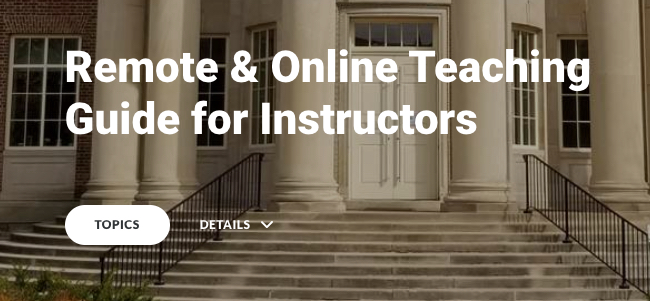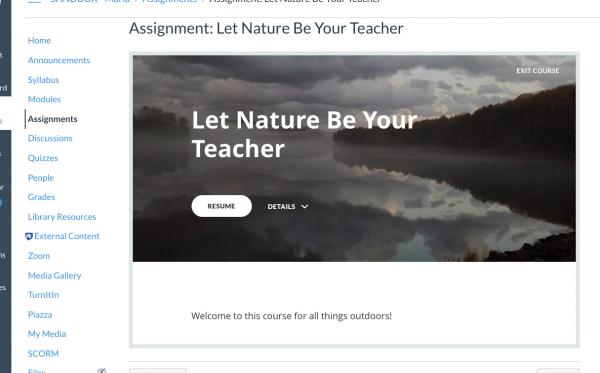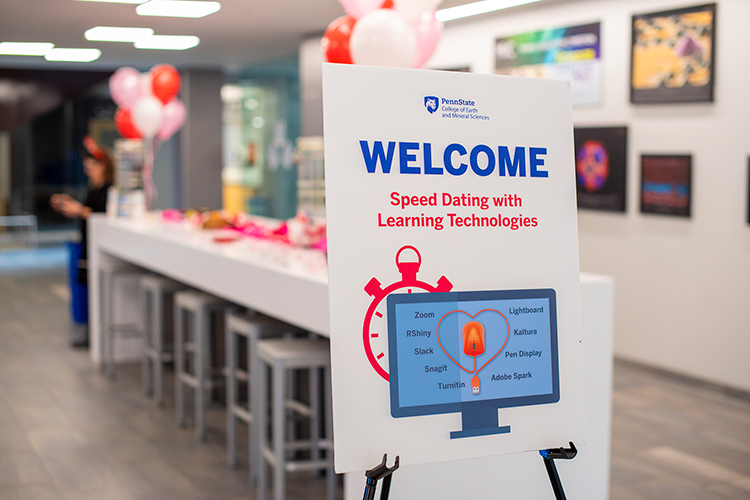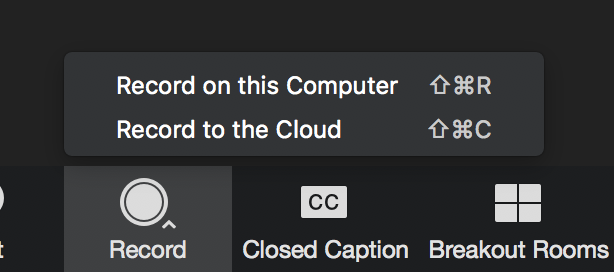The Dutton Digest

Encouraging active learning with interactive videos
Research shows that active engagement helps students learn, so why not include some interactive videos in your course? Whether you prefer third-party YouTube videos from the web or videos you've made yourself, the tool Kaltura (Penn State's tool for working with media) can be used to create interactive videos. Videos can be amended with quiz questions (complete with feedback for chosen answers) or with pauses to give students time to record data from various points. See for yourself and learn more about interactive videos and how to use them with your class -- check out the following examples from the Dutton Institute's Teaching and Learning Showcase:
And speaking of engagement...
IT Learning and Development at Penn State offers excellent ideas for using VoiceThread (a multimedia presentation tool) to make your lectures more engaging! Help students create online presentations and portfolios, and provide opportunities for students to comment on the work of their peers. For more, see ITLD's top 5: Tips for engaging students in your course with VoiceThread.
The article Teach online: Suggestions for learner engagement provides course management tips and a nice table with troubleshooting ideas for problems that may arise in Canvas or during Zoom sessions.
February 2023
Microlearning, or Why a 14-second Plunger Video Is So Effective
Microlearning is the name for breaking down complex or large chunks of content into small, digestible pieces that are delivered at just the right moment, and in an engaging way, so that learners can quickly understand. For example, microlearning is employed by popular language apps such as Babbel or Duolingo, which deliver on-demand, concentrated, mini language lessons. Another example is that quick "how to use a plunger effectively" video you found, just in time, on YouTube. Think "bite-sized takeaway." In the classroom, microlearning can help scaffold learning -- intentionally-delivered building blocks and practice, repetition, and feedback can help students learn and retain new information.
To learn more about microlearning and how to use it effectively with your class, take a look at the following pieces from the Dutton Institute's Teaching and Learning Showcase:
Debunked: Online Learning Doesn't Teach You to Think
This Times Higher Education article called Yes, Online Learning Can Teach You to Think puts forth that quality course design, engaging practices and cultivation of higher-order thinking skills and metacognitive activities all show that online education is valid and not simply a substitute for face-to-face instruction.
"Had I heard him correctly? 'Who else can’t read cursive?'" I asked the class.
"The answer: about two-thirds" (Faust, D.). The Atlantic article Gen Z Never Learned to Read Cursive explores the diminished use of cursive writing. If you're grading papers by hand, it may be worth a look.
Faust, D. (2022). Gen Z never learned to read cursive. The Atlantic, 330(3), 74-6. https://www.theatlantic.com/magazine/archive/2022/10/gen-z-handwriting-teaching-cursive-history/671246/
January 2023

Yellowdig: the Engagement Tool You Didn’t Know You Needed
Finding ways to engage your students in thoughtful and provoking discussions has always been a challenge, not to mention difficult, especially when you must grade 120 responses that all seem to say the same thing. But what if you could engage your students in discussions that actually could be fun for everyone? There’s a bonus, too: the grading can be automated.
The technology is known as Yellowdig, and it’s received rave reviews from students in our courses this fall. The system gamifies online discussions to boost engagement and fun. View the Yellowdig website to learn more or contact Stevie Rocco (srx133) at Dutton for a demo.
A Glimpse into Ed Tech Trends For 2023
No matter what field you’re in, you can’t escape the need for integrating technology into your teaching and learning experiences (especially since the pandemic). But whether you’re tech-savvy or have a casual interest in ed tech, it’s important to be aware of the trends so you can think about how they could potentially impact your students’ learning experience. The article Technology Trends in Higher Education 2023 offers a list of top trends that are worth reviewing. If you decide to pursue integrating any of them into your courses, please let us know! We’d love to hear about your experience.
Microcredentialing and the Comprehensive Learner Record Standard
Microcredentialing has been around for a number of years, but there are many people who have yet to explore this fantastic opportunity for capturing your students’ competencies in a transferable format that provides far more detail than their transcripts. The Comprehensive Learner Record Standard is an important milestone in the microcredentialing initiative for higher education. View this article by IMS Global to learn more about the implications of this new standardized approach.
October 2022
Engaging Students with Interactive Videos
Many instructors supplement their course content by pointing students to engaging TED Talks, asking guest speakers to record short lectures, or providing links to resources through PBS, National Geographic, YouTube, or other online video sources.
Choosing to include video content as part of your class material can provide a number of benefits to the overall student learning experience. These include opportunities to build background knowledge for students, enrich a reading or article with visual context, or provide an alternative point of view, all of which can encourage students to become more engaged in the topic at hand. Another benefit is that students can review videos if they choose, and if the video is properly captioned, use the transcript as an additional resource.
To take your videos a step further, consider adding interactivity. For an activity that is difficult or impossible to implement in a classroom situation, provide a video where the student not only observes the activity but also records data from what they are seeing. Another way to add interactivity to a video is to use Kaltura video software to insert pauses and questions directly into a video to encourage the students to think more deeply about what they are seeing.
The following articles from the Dutton Institute’s Teaching and Learning Showcase provide more information about the use of interactive videos and some examples that are already being used in our courses.
Using Interactive Videos to Encourage Active Learning
- Adding Relevance with Guest Speakers
- Using Interactive Video for a Data Collection Activity
- Using Kaltura to Build Interactivity into Videos

Designing Effective Quizzes, Tests, and Exams
A well-written exam should help assess student learning, show what students do and do not understand, and provide an indication of how effective our teaching is. Writing an exam can be a challenging and time-consuming process, but beginning with some strategies and advanced planning can make the task less daunting. Designing Effective Quizzes, Tests, and Exams by Barbara Gross Davis, UC Berkeley, outlines some helpful guidelines, strategies, and alternative testing modes that you might consider.
September 2022

Task Analysis Activities for Student Success
An excellent way to help students think about their own learning is to partner with them for some task analysis activities. Many students are over-confident about their knowledge of course content and underperform on assessments, so some work with task analysis can be helpful to identify areas of confusion and/or weakness and to help your students make plans for moving forward successfully. Task analysis activities employ reflective work, and typically, are not graded assignments. They help students:
- evaluate their preparation and performance on certain tasks
- consider whether they've made simple mistakes or actually don't understand a concept
- set learning goals
- adjust their future preparatory practices to meet those goals
Task analysis is particularly useful when you follow it with tips for appropriate study strategies and when you offer clarification and assistance.
For more information and examples of activities you can put to work right away, see the following articles from the Dutton Institute's Teaching & Learning Showcase:
Using an Assignment Wrapper for Task Analysis
Using Post-assessment Activities for Task Analysis
Employing Metacognition (Thinking about Your Own Learning) As a Learning Tool
It's So Groovy When the Young Cats Dig 'Ya, Man
You may (or may not) be aware that many of this year's first-year students were born in 2004. They weren't here for 9/11. They still have COVID fatigue. They understand sustainability ... but do they practice it? What do they care about? What sorts of cultural references are familiar to them? Dive into the key factors influencing our first-years with the "Class of 2026" installment of the Marist Mindset List, an annual publication of Marist College. You'll find great fodder for discussion while preventing the dreaded disease hardening of the references!
May 2022

Engaging Learners for Relevancy and Retention
As the semester comes to an end, this is a perfect time to reflect on the experience both you and your students have had over the past several months. You can start this reflection simply by asking, “How was my course a meaningful learning experience for my students?” If you find there may be some room for improvement, consider the concept of Active Learning. The Inside Higher Ed blog post Engaging Learners for Relevancy and Retention provides some considerations for enhancing your course next semester.
Combating Learning Loss
According to The Chronicle of Higher Education, educators today are concerned about the concept of learning loss among their students. This is largely a result of the pandemic and feelings of being overwhelmed. To learn about strategies for re-engaging your students and combating learning loss, attend the free virtual event Countering Learning Loss on Thursday, April 21, at 2 pm Eastern Time (or register to receive a recording).
Rethinking Student Support
The number of academic integrity cases increased during the pandemic. Isolation caused more students than ever to seek support from well-known sites like Course Hero and Chegg (Young). These companies market themselves as fee-based “study” sites for students. In response, Arkansas State University offers an app that allows students to book an appointment with the university’s free tutoring services. This approach makes scheduling easier for students and for tutors, is improving student success, and has resulted in an expanded service portfolio for this university resource. This raises the question of whether it might be effective to replicate their approach of direct marketing, increased visibility, and convenient scheduling to help our own students find each other, tutors, study groups, and office hours. Read more in this EdSurge article: The Pandemic Is Changing How Colleges Offer Tutoring. Will Students Use It?
[Young, J.R. (2022, Oct. 6) With no study buddies, more college students turn to cheating. Edsurge. https://www.edsurge.com/news/2020-10-06-with-no-study-buddies-more-college-students-turn-to-cheating]
April 2022
Increase Student Engagement Through Reflective Writing

We know that students are more likely to remember and understand new material when they're able to connect it to their life-experiences. In the article Using Reflective Writing to Get Students Connected with the Material, Nikole Patson describes how she helps her students do just that with various reflective writing assignments. Her practices include:
- Writing about a memory. Early in the semester, ask your students to write about an experience in their life that relates to the course content.
- Reflecting and connecting to a reading. When reading primary source material, ask your students to write about how the reading relates to their life or something they have learned elsewhere.
- Writing to a future student. At the end of the semester, ask your students to write about an experience in your course that would entice another student to enroll.
Build Student Relationships with a "Relentless Welcome"

Welcoming students into our college during the TEEMS (Total Engagement with EMS) orientation program is an excellent way to make a difference in our young students' college experience. Likewise, building strong relationships with your students by partnering in their learning and being available for them can help them stay motivated and be more successful. The article Activate a Relationship-rich Culture with Three Simple Practices by Maria Scalzi Wherley and Jane Sutterlin presents three strategies for building relationships with your students. Here are a few quick ideas:
- Learn student names. On the first day of class, have students write down their names and pronunciations. Keep the names with you during class and office hours.
- Value persistence. Show students that you are a partner in their learning. Offer flexible office hours, help students practice, and help students help each other.
- Mentor. Say hello to your students outside of class, introduce them to other faculty members, talk to them as co-humans, and listen to them.
EMS Faculty Studio Video Production
The EMS Faculty Studio can help you record and produce high-quality videos for your online and residential courses. View the Record in the Studio or on Location video to see a variety of clips that introduce people and places, explain difficult concepts, demonstrate technical processes, and help students review material. If you are interested in developing some videos, please contact Kay DiMarco (facultystudio@e–education.psu.edu) to schedule a consultation or to plan a visit with her at the EMS Faculty Studio in 4 Hosler Building.
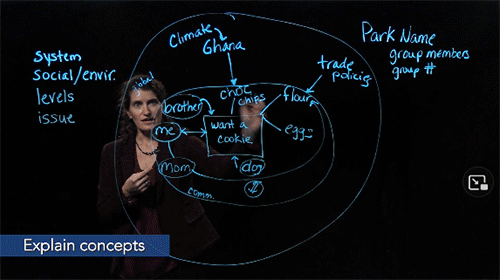
March 21, 2022

Photo credit: EMS Rainbow Network
Making Your Online Class a Safe Space for LGBTQ+ Students
The EMS Rainbow Network, created to support and encourage LGBTQ+ students and their allies to join the research team in Penn State’s College of Earth and Mineral Sciences, is a an example of how EMS actively works to create an inclusive learning environment. These efforts are critical, and it is important that they reach our online students, too.
In the article How to Support LGBTQ Students During Distance Learning, Laura McGuire explains just how important educators can be in the lives of queer or gender nonconforming students. Though first offered for teens who had to shift online during the pandemic, her suggested strategies translate to college-age students learning online.
Tips
- Create an open and affirming classroom: Commit to an environment where students feel safe. Share your name and pronouns and invite students to share theirs, but make it optional. Example: “Please share your name and any other information you would like us to know; this could include your pronouns, where you are from, or some of your personal interests.”
- Weave inclusivity into lessons: McGuire recommends highlighting LGBTQ leaders in the field/subject you are teaching and points out that “Discussing the contributions of diverse scholars, scientists, and authors can mean the difference between a student feeling erased and seeing that their future is indeed bright and a path well-traveled by those before them.”
- Observe and support: When a student is falling behind or struggling, reach out to them if possible. If a student shares that they are struggling due to their identity, be prepared to provide resources for support.
The Office for the Advancement of Teaching at the University of the Philippines Diliman offers the following Tips on How to Make Your (Online) Class a Safe Space for LGBTQ+ Students:
- Respond to anti-LGBT language or behavior
- Recognize and respect students’ lived names, pronouns, and titles
- Discuss ground rules and expectations from the start of the class
- Provide clear, thorough, and honest discussion on guidelines for privacy and confidentiality
Resources
Penn State Student Affairs’ LGBTQ+ Information for Faculty and Staff provides excellent resources for the use of pronouns in your email signature, for sample syllabus language, and for suggestions to incorporate LGBTQ+ subject materials into class curriculum.
The National Education Association (NEA) Center for Social Justice suggests creating visible signs, like Zoom backgrounds or posters to demonstrate to students that you are LGBTQ+ affirming:
Penn State's outstanding LGBTQ+ workshops for Faculty and Staff:
- Safer People Safer Places Foundations Workshops: In-person April 11, 2022, 8-10 a.m., and Webinar April 26, 2022, 8-10 a.m.
- Safer People Safer Places Transgender and Gender Inclusion 101 Workshop: Webinar April 19, 2022, 8-10 a.m.
A variety of resources
February 28, 2022
Blended, Hybrid, and Flipped Learning are techniques that allow instructors to take the best of online and in-person instruction and combine them. If you've ever been interested in exploring a different mode of instruction, now is your chance. Designing the New Normal: Enable, Engage, Elevate, and Extend Student Learning is a 15-minute read that provides both guidance and frameworks to help plan and develop a blended or hybrid course.
No matter how you teach, 15 Ways to Engage your Students In-Person, Online, and in Zoom may help you engage your students in class.
It is well-known that if you want to determine if someone really knows something, have them teach it. Consider introducing your class to Student-Led Lessons Rather than Student Presentations.
Build your understanding in areas that will enhance your teaching: The Chronicle of Higher Education has a series of newsletters that supplies helpful information and tips. Consider signing up for the Teaching-focused newsletter to read stories like The Myth of the Natural Teacher and How to Become a Better Teacher.
Finally, visit the website for Leadership in STEM Fields: Increasing Leadership from Historically Underrepresented Groups, to access recordings of presentations and discussions held at this recent three-day event. This workshop series, sponsored by the National Science Foundation and presented by Penn State and Intersections SBD Consulting, brought together prominent current and past leaders of Federal agencies, foundations, and academic institutions to share inspirational stories, discussion, and analysis of how to increase the number of STEM-field leaders from underrepresented groups.

author of A Lab of One's Own: One Woman's Personal Journey through Sexism in Science
Credit: Dutton Institute. "Leadership in STEM Fields Day 1 Workshop with Rita Colwell." YouTube. Jan. 27, 2022.

Screencapture from The Scholarly Teacher
New ideas at your fingertips!
February 14, 2022
Review a number of different teaching strategies quickly with the Scholarly Teacher’s Teaching Tips infographics. Get the gist in a jiffy so that you can implement something new:
Working with Disability Services
Did you know that Penn State Disability Services is a resource for you and not just for students? Join Terry Watson and Maggie Kwok of Penn State World Campus to learn more about support for your teaching. Attend the March 30 Webinar, noon-1 p.m.: Faculty Engaging with Disability Services: How should faculty and disability services work together?
Making Grading Easier
The Comment Library in Canvas's SpeedGrader can save you time! While individualized feedback is essential, it can be preceded by standard comments that you may wish to offer to many students. The Comment Library allows you to save and reuse comments, and you can access them from every course in which you're an instructor. Learn more with the Comment Library instructor guide or via this Comment Library screencast (1:40 min.)
Why use Twitter?
There are lots of reasons! The Center for Online Education offers 50 ways to use Twitter in the College Classroom. A few of our favorites include:
Find directions for embedding the Twitter Widget from the University of Oklahoma.
Ready, Set, Engage!
January 31, 2022
The semester has started, and we’re all busy with classes, assignments, grading, and deadlines. But don’t miss this advice from Sara Rose Cavanagh: “Once you’ve hit the groove in your semester where everything is running smoothly,… shake things up.” Her advice guide, How to Make Your Teaching More Engaging, offers more.
More engagement ideas can be found in the Flexible Instruction Teaching Guide developed by the Dutton Institute learning designers.
If you’re concerned that this will take more time than you’ve got, never fear! In February, Teaching and Learning with Technology (TLT) will be holding sessions on areas of interest to the University community, including a session on Time Management Strategies for the Busy Engaging Instructor. And don’t forget Sara Rose Cavanagh’s The Spark of Learning: Energizing the College Classroom with the Science of Emotion, which is available as an e-book via the Penn State Libraries.

Photo by Ales Krivec on Unsplash
Embracing the start of a new year
January 18, 2022
Teaching Resources
If you offer extra credit opportunities for your students, take some time to evaluate your practice with a critical eye. The article Use Revise and Resubmit Instead of Extra Credit makes an excellent case for motivating students with rewards for persistence instead of awarding points for work that doesn't help improve deficiencies.
Maybe you use group projects to encourage collaboration and mirror "real-world" teamwork. But do you teach how to effectively engage in teamwork? The Chronicle of Higher Ed's Why and How to Teach Teamwork has ideas you can put to use immediately.
It's pretty well known that active participants learn more than passive listeners and that when students can discuss their ideas with their peers, knowledge is shared and misconceptions can be addressed and clarified. To help both of these things occur in your classroom, consider the brief advice in Three Questions to Help Facilitate Effective Classroom Discussions, which is focused on strengthening "students' ability to lead, critically think, and assess their own learning."
Advancing Inclusive Teaching
In an effort to better address inclusivity and accessibility, faculty development at Penn State World Campus will offer revamped versions of several of their courses, which take place online and are free of charge to Penn State faculty, staff, and graduate students. These courses provide valuable, practical information for all instructors (face-to-face and online). Registration is currently open for courses that run this spring! For more information, see the article Online Courses Include Focus on Inclusiveness, Accessibility.
Our own Schreyer Institute for Teaching Excellence offers Strategies for Inclusive Teaching, a resource designed to help instructors evaluate course content and materials, help promote opportunities for success, and to foster inclusivity. For a deeper dive, dig into A Tool to Advance Inclusive Teaching Efforts: The "Who's in Class?" Form. This short journal article cites reported benefits from use of the "Who's in Class" form, a tool (provided for you) developed to increase awareness of "learners' diverse attributes and identities" and the "implementation of inclusive teaching practices."
Winding Down the Semester and the Year
December 6, 2021
Noteworthy
Produced by our colleagues at Teaching and Learning with Technology here at University Park, How to Support Students with Disabilities is an infographic that shares feedback from a student survey. Learn how you can help with virtual office hours, organized Canvas spaces, and flexible deadlines.
If you're in need of a Tech TA for Spring '22 (for Zoom and Canvas support), starting on December 8, you can visit the Tech Tutors & TAs website and fill out an Academic Course or One-time Event form. Tech TAs can help with audiovisual issues, can record sessions, take attendance, migrate/input course content in Canvas, activate Learning Tool Integrations, and more.
Information Technology Learning and Development (ITLD) will hold its annual Winterfest between December 13 and January 7. See the schedule of events for December sessions on Top Hat, Kaltura, and Canvas.
Penn State's Data Storage Finder page can help you find storage solutions! Search for a solution to meet your needs, or compare services with their handy table.
Practical Advice for the Classroom
Cultivating good practices for teaching and grading student writing takes time and work. Two recent articles offer practical advice:
Finally, as the pandemic wears on....and on, and we continually learn how to cope, we can all use advice on which practices work and which don't. Here are some ideas to try:
Should You Consider Flipped Learning in Your Classroom?
November 8, 2021
In this issue, we'll continue the engagement theme with a strategy called flipping the classroom, which is a way to make learning more active. Have you ever thought, “I wish I had more time to work with my students on ___.”? In a flipped classroom you can, by shifting some lectures and activities online. The additional in-person time can then be used for activities that require higher-order thinking. Four key elements ensure that flipping your classroom is successful:
Learn more in the articles Flipped learning: What is it, and when is it effective? and Flipping the college classroom for enhanced student learning.
These Penn State resources can help you make the flip:
- Record yourself using Zoom and share the video with your class using Kaltura
- Create a Canvas quiz to make sure that your students watch the video and understand what was presented to them before class
- Have students complete an assignment in class to apply what they learned online
Did You Know?
- Zoom has been updated to allow chatting with waiting room folks, which could be a nice feature for office hours. There are also new seasonal immersive backgrounds!
- Canvas training, available every month from Penn State’s Learning Resource Network, is coming up on November 18 at 10a.m. Learn how to identify essential and recommended tasks to complete at the beginning and end of each semester.
Why Does Student Engagement Matter?
October 25, 2021
The (somewhat unengaging) answer, according to the Glossary of Education Reform, is not too shocking: “learning improves when students are inquisitive, interested, or inspired, and that learning tends to suffer when students are bored, dispassionate, disaffected, or otherwise “disengaged.”
Interested in learning more?
Great! Sarah Rose Cavanaugh (psychologist and professor) can help! Her Advice Guide from The Chronicle of Higher Ed, How to Make Your Teaching More Engaging, explains why these powerful practices are worth your attention, demonstrates how you can put them to work, and provides real-world classroom examples for each:
- Tapping into the emotions of your students (because our cognitive resources become focused when our emotions are hooked)
- Understanding that a little bit of performance can go a long way (because enthusiasm is contagious)
- Embracing an atmosphere of community (essential for helping people feel welcome and valued)
- Harnessing the power of storytelling (which help learners understand and remember)
Of course, Penn State’s all over this subject, too, with ideas, strategies, and resources. Here is a bunch you can check out today:
From the Keep Teaching website
- Engaging students during class
- Engaging students during office hours
- Engaging students with study groups
Penn State's Learning Resource Network (LRN) provides the following training; log in to the LRN with your Penn State Account and search for these titles:
- Igniting Emotional Engagement (46 minutes)
- Tips for Learner Engagement (33 minutes)
- Learning How to Increase Learner Engagement (41 minutes)
If your interest is really piqued, check out Cavanaugh’s excellent book, which is fully accessible online via the PSU Libraries: The Spark of Learning: Energizing the College Classroom with the Science of Emotion.
Presentation Refreshers

October 11, 2021
Practicing a presentation before you give it is always a good idea; we all want to be effective! Microsoft PowerPoint for Web allows you to rehearse with Presenter Coach, a program that evaluates you and offers suggestions for improvement! Check out this feature for yourself or share this tip with your students.
Can you put too many words on a PowerPoint slide? Research has shown that even when you read aloud what is written on a slide that contains many words, comprehension and memory decrease. Our brains can’t read and listen at the same time. Use relevant images and include only keywords (that might not be heard or may be misspelled by listeners) for presentations. Here are some resources:
- It's Not PowerPoint's Fault; You're Just Using it Wrong
- Am I Pretty? 10 Tips to Designing Visually Appealing Slideware Presentations
- Chapter 1 of Stop Talking, Start Influencing: 12 Insights from Brain Science to Make Your Message Stick p. 16-25
- The Vanderbilt Center for Teaching's page on Making Better PowerPoint Presentations
Hybrid Meetings
Presenting in hybrid meetings has its own challenges! Check out these ideas from CNN to keep in mind when presenting or teaching in a hybrid environment.
Connecting with Generation Z
September 27, 2021
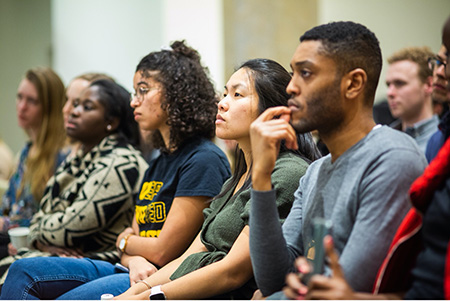
Generation Z refers to people born between 1997 and 2012. They make up our core student demographic and like millennials, they are unique. Following are some great resources for working with Gen Z students effectively.
So what, exactly, makes Gen Z students unique? Understanding Gen Z Students, an infographic from Generation Z: A Century in the Making, outlines nine findings on Gen Z learning preferences. And the article 3 Generation Z Traits Today’s Teachers Need to Adapt to offers valuable suggestions for how instructors can approach working with this group of learners.
The two short articles Generation Z: Re-thinking Teaching and Learning Strategies and Generation Z: Educating and Engaging the Next Generation of Students discuss Gen Z characteristics and learning preferences and provide suggestions for how to effectively connect and engage with this group of students.
Finally, because Gen Z is the most diverse group of learners yet in higher education in the U.S., inclusivity is as important as ever. How to Make Your Teaching More Inclusive and Race on Campus: You've Embraced Inclusive Teaching, But is it Working? examine how instructors can create a learning environment that reflects and respects the backgrounds, cultures, and beliefs of all students.

Rejuvenating Both Work and Life
September 13, 2021
Feeling meh? Need a little pick-me-up? Many of us are feeling this way at this point in the pandemic. Rejuvenate with some of these recent finds:
- Six Ways To Fall in Love with Teaching Again – This article suggests some great ways to reenergize! And spoiler alert – the Dutton Institute’s Learning Design Team can help with #6.
- How Technology and Learning Science Can Change Your Teaching – Check out this webinar hosted by our very own learning design faculty, Maria Wherley and Jane Sutterlin. Continued research in learning science informs recommendations on how instructors can help students learn and commit new ideas and material to long-term memory. There's a struggle, though, between what science has to say and what happens in classrooms. In this webinar, Maria and Jane discuss how technology and learning science can improve teaching.
- How to Stop Languishing and Start Finding Flow – This TED Talk by organizational psychologist Adam Grant offers wonderful guidance on how to get back into the groove!
Job Aids
Having go-to resources at the ready is always helpful, especially for busy instructors. These handy websites are bookmark-worthy!
- OER Flowchart – Sometimes, it's hard to know where to start to find free or low-cost course materials for your students. This tool, developed by our colleagues at University Libraries, will show you the way!
- Bloom’s Taxonomy: Teacher Planning Kit – Want to guide your students from lower-level thinking skills to higher-level ones but sometimes struggle with how to know if they are “getting it?” This useful chart is a great cheat-sheet for creating learning objectives and corresponding assessment strategies at every level of the famous Bloom’s Taxonomy, a framework for organizing educational goals into six categories (knowledge, comprehension, application, analysis, synthesis, and evaluation) along a continuum of thinking skill complexity.
- You@PSU - Looking for resources related to helping your students…and yourself…to succeed, thrive, and matter? Check out @PSU, a new site where you can find information and resources 24/7.

Looking Forward
During this school year, the remote environment both challenged and saved us, and some of the practices we’ve adopted will stick with us as we move forward.
The following articles share recent innovations that instructors have come to appreciate:
And for Wellness:
Feeling a bit burned out? You might want to jump out of a plane! Or... just take a break. Read Work-life Balance: Break or Burn Out, in Nature, from way back in the Before Times year of 2017.
And if you really want to dive into managing burnout (instead of into the sky from 10,000 feet), check out Pandemic Burnout is Rampant in Academia, also in Nature.
Lessons Learned
Reflecting on the past year: What was your experience like with remote teaching? The Chronicle of Higher Education puts forth an article titled: A Year of Remote Teaching: the Good, the Bad, and the Next Steps.
Interesting Statistics about Student Engagement: Brandon Busteed, President of Kaplan University, makes the interesting claim that “…fully online college students are twice as likely to say they are ‘comfortable sharing their opinions in class’ compared to fully in-person students.” Read the article in Forbes to learn more.
Thinking About the Future: The PR Newswire shares the survey results on faculty perceptions of online learning, post-pandemic. Interestingly, nearly half (47%) of all faculty surveyed anticipate retaining many of the changes made during the pandemic once face-to-face instruction returns.
A Comprehensive Guide on Blended Learning: As we think about the “new normal,” it’s important to consider an educational future with enhanced learning opportunities. This Blended Learning Toolkit from the University of Central Florida can help you think about designing classrooms with more flexibility.
Upcoming Webinar! Who's Passing, Who's Failing: An Honest Conversation about Academic Integrity is an all-day event on Friday, April 16.
And finally, a word on wellness: Learn how HDFS Professor Molly Countermine starts every class with a mindful practice to combat stress. Watch her TEDxPSU talk (13 minutes), Life Isn't Supposed to be Good ... All the Time.
Upcoming Webinar: Enhance your Class sessions with "Small Teaching" is a Keep Teaching Webinar offered this Wednesday, March 24th at 12:05 pm (Eastern). This seminar is inspired by James Lang’s Small Teaching, a favorite of the Dutton Learning Design team. Attend to learn some easy-to-implement “small but powerful instructional and assessment activities that promote students’ engagement, motivation, and achievement.” Check the Keep Teaching website for upcoming webinars of interest.
Accessibility Update: Did you know that Zoom offers live, automatic captioning? While the accuracy of the captioning varies depending on background noise, accent, etc., the overall result is valuable for all students, not just for those with hearing impairments.
Asynchronous Video: Educause has produced a series of seven blog posts. There's something for everyone:
Stay Sane with some March Madness: I scream, you scream, we all scream for ICE CREAM! Join in the Creamery’s March Flavor Madness contest and place your vote!


Attending to Some Items of Importance
In the weekly blog, “Teaching,” for The Chronicle of Higher Education, Beth McMurtie presents the case for taking the time to acknowledge the experiences we’ve all had this year. Take a break and read The Importance of Grieving.
New tips for working with Zoom can be found on Penn State’s Service Disruptions page, where you’ll find guidance for making alternative plans, and at the Public Knowledge Base site, where you can learn how and why you should allow participants in your Zoom meetings to Add Gender or Identity Pronouns to their display names.
In an effort to harness the full power of your mind, check out Distracted Minds: How to Fix Your Attention Shortage by James Lang, which addresses instructors instead of students.
Commit to equitable learning and the support of a diverse student population: explore the new Inclusive Online Teaching Certificate offered by World Campus Online Faculty Development.
And finally, embrace wellness! To get your body clock back on track, check out How to Fix Your Sleep Schedule from Everyday Health.
Add Some Fun with Improv Games!
At the February 9 Wellness Day, World Campus learning designer Penny Ralston-Berg led an interactive Zoom session on how to use simple improv games to add fun to online and resident courses alike. Use improv games to build community and encourage interaction! Here’s a link to some ideas and literature about improv games.
More Ideas for Interaction
Are your online discussions getting monotonous? Are you looking for a way to ensure that your discussions help you evaluate your learning objectives? Take a look at Leveraging Bloom’s Taxonomy to Elevate Discussion Boards in Online Courses from Faculty Focus.
Whether you are new to leading online discussions or are looking to refresh some of the discussions in your course, an article from Faculty Focus may be of interest: How to Make Your Virtual Discussions Engaging, Effective, and Equitable in Eight Steps.
Distracted Minds: Your Classroom Can Be a Retreat in Dark Times describes the psychology behind sustaining students’ attention in the classroom and how it contributes to both student learning and well-being.
Self-care
William Robertson, of the University of Texas at El Paso, shares his practices for maintaining balance in Personal and Professional Health When Teaching Online: A Six Faceted Approach. From The Scholarly Teacher.

Our First Wellness Day is February 9, 2021
What do you have planned to actively practice your commitment to wellness and well-being? Hopefully, you are able to take advantage of PSU Events or take some time to build healthy habits, understand your needs and invest in yourself.
Here is a beautiful 15-minute 360 Degree Virtual Reality Meditation video if you are not able to get outside.
Teaching
The World Campus has released the schedule for OL 2400: Integrating the Library into Your Online Course. The library wants to partner with you to better the experience for all students. The first session starts in March and is instructor-led for 4 weeks. Check out the complete Spring/Summer Schedule.
Are you Listening to All Students? In this article by Fierce Education, the author shares a study that shows male students speak 1.6 times as often as female counterparts.
How To Read an Academic Paper from the Learning Scientists' Feb 2 blog post has some great suggestions for students struggling on how to best read academic articles.
Do Instructional Videos Work Better When the Teacher is On Screen? It really depends. Read this article by Edsurge.com to investigate further. And remember, EMS has a lightboard studio available by appointment with our multimedia specialist and videographer, Kay DiMarco.
Need some ideas for building your classroom community online? Dr. Catlin Tucker suggests 3 tips.
Coming Soon
In an upcoming February Canvas update, users will be able to type LaTeX equations into ANY Canvas text field, and MathJax is loaded if Canvas detects an equation image added by delimited LaTeX characters. Watch the video Courses: MathJax and LaTeX (2021-02-20) Release (1 minute) for a demonstration.
Easing into the Spring 2021 Semester
We’re one week into the Spring 2021 semester and are beginning to settle into socially distanced routines that we never would have imagined a year ago. Here are a few resources that might be helpful as we proceed.
Teaching
Encourage more activity in your breakout rooms: How to Make Breakout Rooms Work Better, from the Chronicle of Higher Education, provides some helpful ideas for making breakout rooms more effective, including assigning roles, using shared documents, finding the right group size, and giving students agency.
Chrome has an extension that can help simplify your Canvas Inbox and make your use of Speedgrader more efficient. The Canvas Betterizer extension lets you simplify the messages window, save and enter frequently use grading comments, enter grades and move on to the next student automatically, and more.
Use the Canvas Course Link Validator to scan your course and return a list of invalid or unresponsive links.
Wellness
No spring break, no problem. After deciding to eliminate Spring Break from the 2021 Spring semester to help reduce travel and the spread of the Coronavirus, Penn State announced the dates for three Spring 2021 wellness days. You can also check out the Penn State Wellness Days site for ideas about how to make good use of these days.
If you have students in the State College area who are struggling with COVID-19-related issues, the Penn State Student Affairs COVID-19 Resources page has information about Penn State’s Lion’s Pantry, Counseling and Psychological Services (CAPS), quarantining and self-isolating, and more.
Penn State Resources Worth Revisiting
Penn State’s Instructor Guide for Upcoming Semester Course Planning site isn’t just for pre-semester planning! This is a one-stop resource for information about technology and training resources, best practices for teaching in remote modes, handling student absences, enforcing health and safety requirements, and many more relevant topics.
The Penn State Keep Teaching site is full of up-to-date information about webinars, policy guidelines and documents, health and safety, and a variety of teaching topics.
Today, Tomorrow and Beyond is the theme for this issue.
Today...
Maintain instructor presence in the classroom with Zoom's new Virtual Background feature. You'll be seen easily during remote lectures, as you’re pictured with your slides behind you.
To Spark Discussion in a Zoom Class, Try a “Silent Meeting.” This article, from the Chronicle of Higher Ed., offers a great idea that you can implement immediately.
If you’re still prepping your final exam, the Canvas Quiz Converter created by San Diego State University might be a helpful resource, as it allows you to convert a text file into a Canvas quiz.
Tomorrow...
The cloud-based tool Top Hat offers a variety of options for enhancing the teaching and learning experience. Top Hat can help you track attendance and engage learners. Check out the website to view pre-recorded lectures as you begin planning the spring semester.
One aspect of concern for instructors has been the need to foster a greater sense of community in the classroom. Read 7 Activities to Build Community and Positive Classroom Culture During Online Learning for some fun and creative ways to help your students connect and be well.
Beyond...
There is no doubt that our lives have been and will continue to be impacted by this pandemic, but what will education look like in the times ahead? Jim Fong, Lead Consultant and Founding Director of UPCEA’s Center for Research and Strategy, shares his thoughts on the future of education in an article titled The Lego™ Generation, Stackable Credentials and the New Economy.
This issue is focused on the Nov 20 transition to remote teaching.
Here are essential guides and support documents:
We'll leave you with an inclusivity tip:
Canvas users can now add their preferred pronouns to their user accounts. When enabled, chosen pronouns will appear after your name. Download complete instructions for enabling pronouns here.
October 26, 2020
We’re all about Student Engagement this week. And staying well!
Check out our newly-revised resource Adding engagement to your classroom. You’ll find instructions for remote synchronous and multiple audience classes of all sizes and ideas for working with groups, pairs, or individual students.
Keep Engaging Series webinars are coming up on Mondays (noon-1) in November. No registration is necessary; simply use this Zoom link. See Keep Teaching’s Webinar page for more information, including how to access recordings. You can also refer to TLT’s Engaging Students Series Resources Pressbook to scan similar topics.
Explore using EquatIO, an equations app that’s free to all Penn Staters, to read and write math in a digital environment. EquatIO is easy for you and for students to use. Consider, also, that uploaded EquatIO homework can be graded with annotation with the help of Canvas’s Speedgrader tool.
Check out this video EdTech tip to learn about splitscreening and screenshotting, which can improve your virtual classroom by helping you show students more and allowing them to see more of your screens as you teach.
To maintain wellness and ward off feelings of being overwhelmed or depressed with these ideas from Understood.org’s article Practicing Self-Care During Coronavirus: 5 Tips for Teachers.
See more in a 2-minute video full of science-based well-being tips to help you through the pandemic.
October 12, 2020
Here's what we're thinking about right now:
Penn State has finalized an enterprise-wide service agreement with Top Hat. Top Hat is a cloud-based teaching tool that enhances in-class engagement. Students work with their own devices, and instructors can take attendance, present interactive slides, launch polling, and administer quizzes. Check out TopHat.psu.edu for more information or consult with a Dutton Learning Designer to discuss how you can get started.
Virtual Facilitation? Try Discussion Mapping, is an article from Learning Solutions that provides examples of discussion mapping for use in your classes, whether they are face-to-face or remote: The practice of Discussion Mapping is a method of recording, quickly, the participation of students in class discussions. It can help create a clear picture of group dynamics, which can help you shore up your facilitator game.
The Engaging Student Series from Teaching and Learning with Technology continues! Check out the list of upcoming presentations related to blended asynchronous and synchronous teaching, and take advantage of their ESS Pressbook.
Are students contacting you about disappointing grades? These handouts are designed to provide students with suggestions, based in learning science research, on how to Study Smarter and Not Harder.
From the Chronicle of Higher Ed.: Don't Weed out Students. Help Them Flourish focuses on coaching your students instead of judging them.
And from West Virginia University Press, the Teaching and Learning Series Pedagogies of Care, an offering of open resources (videos, podcasts, infographics, articles, etc.) based in "student-centered practices and adaptive strategies" that are available for your use during these challenging times. Find refreshing ideas about teaching, collaborative practices, and assessment.

September 28, 2020

These are items we're thinking about and are investigating just now:
Use Nearpod to engage students in the classroom and those participating online. Nearpod is a presentation and engagement tool that allows students to engage with lessons, quizzes, polls, and other interactive elements in real time and on their own devices. And it integrates with Canvas, Zoom, and Microsoft. The Center for Teaching Excellence at the Harrisburg Campus provides a great overview.
The Assessment Institute, hosted by IUPUI, is entirely virtual and entirely free this year, and they’ve just added a Bonus Preview Session on “Adapting Assessment Approaches in the COIVD-19 Era” for Friday, October 16, 2020. The institute is the premier conference on the topic. Register and find full details at The Assessment Institute.
Following are a few resources your students might find helpful:
The article Engaging Students Through Asynchronous Video-Based Discussions in Online Courses from the Educause Review is a great read if you are looking at ways to engage your asynchronous classroom in discussion.
Welcome to the Dutton Institute’s Bi-weekly Digest!
September 16, 2020
Here’s what we’re thinking about this week – what we’re reading, pondering, and putting to use:
From FacultyFocus.com, some great ideas for how to connect with the emotional lives of students, and a great reminder that relevance and engagement go hand in hand: Can We Talk About it? Enhancing Student Engagement by Integrating Discussions of COVID-19
If you’re using Zoom polling for attendance or participation, you’ll want to see this quick video (< 5 min.) from our own Jane Sutterlin, Learning Designer: Using Excel to Add Zoom Polling Data to Your Canvas Gradebook. There’s even more on polling here, in our Remote & Online Teaching Guide: Polling.
More on engagement comes from Educause Review and Creating Emotional Engagement in Online Learning. This article gets straight to the point with three major tips.
Another (entertaining!) video, Making Super Simple Videos for Teaching Online, helps break down any fears you have about taking the leap to include DIY videos in your course (in about 10 minutes).
Take care of yourself! Visit The Tree of Contemplative Practices for inspiration. For more explanation, click on the ideas hanging in the tree.






